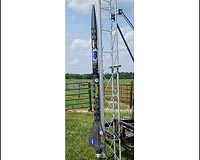 |
Seoul (AFP) Aug 25, 2009 South Korea was preparing to launch its first space rocket later Tuesday, six days after a software glitch halted the countdown just eight minutes before blast-off. The project to put a South Korean satellite into orbit, operated in partnership with Russia, has been delayed seven times in recent years. "We've fixed the computer software problem and overhauled all other software. We hope the launch will go ahead as scheduled this time," Lee Joo-Jin, who heads the Korea Aerospace Research Institute, told journalists. The Korea Space Launch Vehicle-1 (KSLV-1) was scheduled to blast off from the Naro Space Centre at Goheung on the south coast around 5:00 pm (0800 GMT). The science and technology ministry said a full rehearsal Monday showed it was ready for lift-off. Seoul has invested 502.5 billion won (419 million dollars) and much national pride in the 33-metre (108-foot) rocket, whose first stage was built in Russia and the second stage by local engineers. If the launch is a success, South Korea will become the world's 10th country to send a home-grown satellite into orbit from its own soil. Rival North Korea, smarting over UN Security Council censure of its own rocket launch in April, has said it will watch closely to see whether world powers also refer the South Korean launch to the Council. Pyongyang insists it was unfairly punished for its April 5 launch, saying it merely put a peaceful communications satellite into orbit. Washington and its allies have said no satellite was detected in orbit and the North's launch was a disguised test of a Taepodong-2 missile. Seoul has bristled at any comparisons with its neighbour's operation, insisting its own project is purely for scientific purposes. South Korea built the 100-kilogram (220-pound) scientific research satellite. Although the rocket's first stage was Russian-made, experts said they had gained valuable know-how that could enable them to build their own launch vehicle by 2018. Fuel injection will start two hours before the launch and the engines will be ignited 3.8 seconds before lift-off. The first seconds will be crucial as the main engine pushes the 140-ton rocket relatively slowly off the launch pad. "If there is a sudden gust of strong wind or any other slight problem in the stabilisation mechanism, the rocket can tip over and be lost," Min Kyung-Ju, head of the Naro Space Centre, told Yonhap news agency. At 215 seconds after lift-off, the protective covering at the rocket's tip is scheduled to be ejected at an altitude of 177 km (110 miles). The first stage will fall away 232 seconds after lift-off, at an altitude of 196 km, falling into the sea near the Philippines. At 395 seconds after launch, the second-stage rocket will ignite at an altitude of 303 km. It will put the satellite into orbit 540 seconds after launch if all goes to plan. An initial assessment on whether the launch has been successful will be announced about an hour after lift-off. The satellite will take 103 minutes to orbit the earth from north to south. Its first signal is expected to come 12 or 13 hours after lift-off. South Korea has previously sent 10 satellites into space using launch vehicles from other countries. In November 2007 it announced a plan to launch a lunar orbiter by 2020 and to send a probe to the moon five years after that. South Korea unveiled the project one month after China launched its first lunar orbiter and two months after Japan did the same. In April last year Seoul sent its first astronaut into space aboard a Russian Soyuz rocket. Share This Article With Planet Earth
Related Links Rocket Science News at Space-Travel.Com
 First Launch Of Test Rocket Fueled By Aluminum-Ice Propellant
First Launch Of Test Rocket Fueled By Aluminum-Ice PropellantArlington VA (SPX) Aug 24, 2009 The Air Force Office of Scientific Research (AFOSR) and NASA recently announced the launch of an environmentally-friendly, safe propellant comprised of aluminum powder and water ice (ALICE). "By funding this collaborative research with NASA, Purdue and The Pennsylvania State University, AFOSR continues to promote basic research breakthroughs for the future of the Air Force", said ... read more |
|
| The content herein, unless otherwise known to be public domain, are Copyright 1995-2009 - SpaceDaily. AFP and UPI Wire Stories are copyright Agence France-Presse and United Press International. ESA Portal Reports are copyright European Space Agency. All NASA sourced material is public domain. Additional copyrights may apply in whole or part to other bona fide parties. Advertising does not imply endorsement,agreement or approval of any opinions, statements or information provided by SpaceDaily on any Web page published or hosted by SpaceDaily. Privacy Statement |